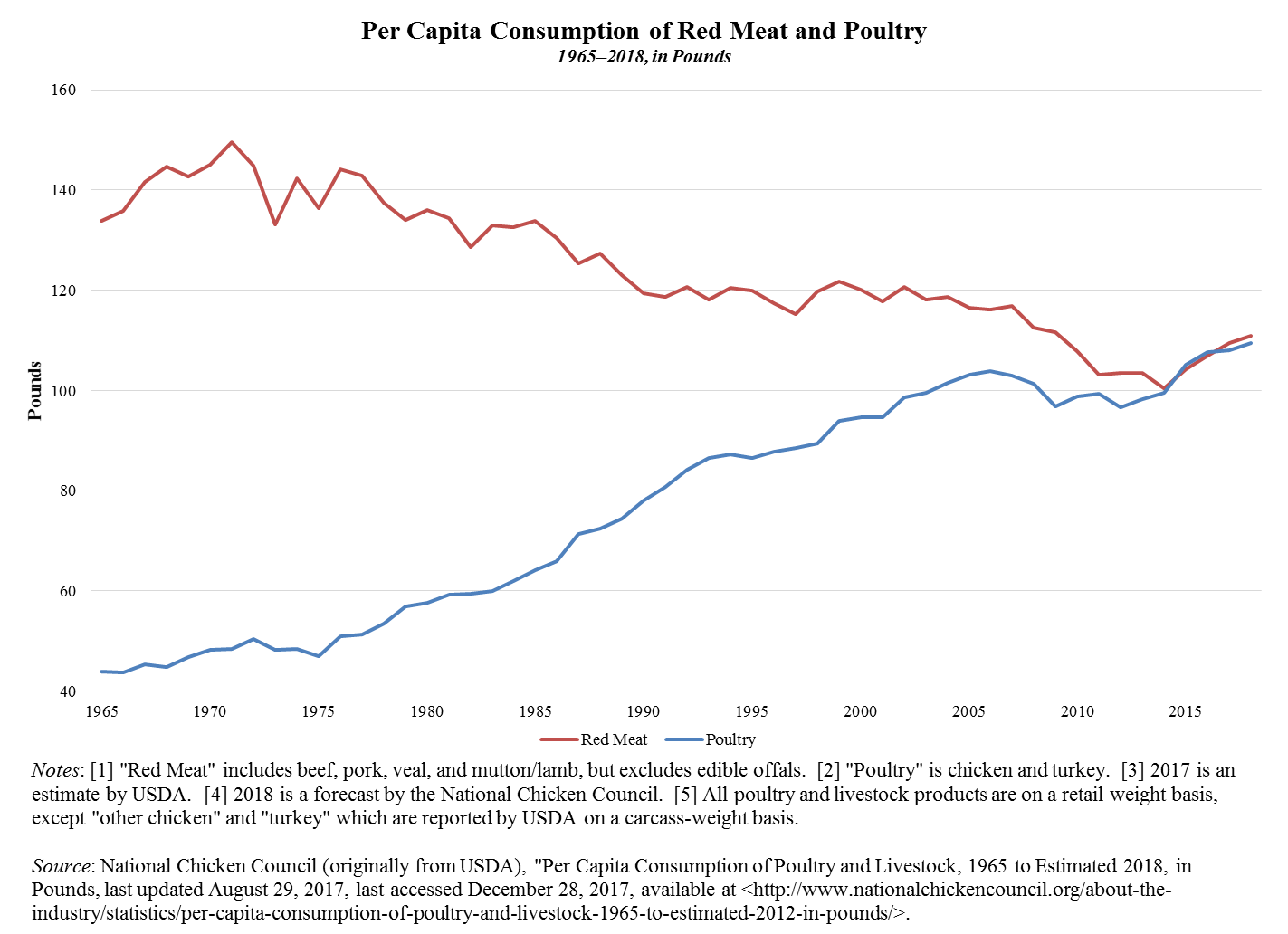I recently watched the Netflix movie “Okja”. It was a great movie that I recommend to everyone. IMDB characterizes Okja as “action, adventure, and drama” but animal rights is also a main theme of the movie.
I wonder if Mija’s favorite meal at the end of the movie is still chicken soup.
At the beginning of the movie we learn that Mija’s favorite meal is chicken stew. 1
As shown in the graphic below, consumption of red meat (mostly beef and pork) has been overall decreasing since 1965 while consumption of poultry (mostly chicken) has been increasing.
From a vegan/animal activist point of view, it’s important to encourage meat-eaters who are reducing consumption of red meat (usually for health or environmental reasons) but to also remind them that animals
are living beings that are mistreated right from the beginning of their unnaturally short lives. Replacing red meat consumption with poultry consumption is definitely not a happy result for the birds!
From a health and environmental perspective, it is certainly best to replace meat with plants.

Okja is an intelligent animal
In the first 15 minutes of the movie, Okja saves Mija’s life. Mija slips and falls off the edge of a cliff, holding onto a rope. Okja quickly grabs onto the other end of the rope.
Slipping on the rocks, with Mija dangling off the edge, Okja makes a last-minute decision to twist the rope around a nearby tree branch to hoist Mija up while Okja goes tumbling into the forest below.2
During the scene, the camera even switches to Okja’s perspective as we see her thinking about what to do and seeing the nearby tree branch. From the beginning of the movie, Okja is established
as an intelligent animal. This makes the viewer feel that Okja is special and worth saving. Animal intelligence is a trait often used to justify eating fish and poultry but not pork.
If it’s cheap, they’ll eat it
In response to Frank’s comment about how customers will react after the debacle in New York, Nancy Mirando responds with “if it’s cheap, they’ll eat it.” 3 This line really struck a chord with me. It’s easiest to fight for something when its convenient for you. What’s really important is that you stick with it when things get tough.
The movie is not afraid to show the true horrors of animal agriculture.
The movie shows very disturbing scenes of practices typical in animal agriculture, such as forced insemination of females, pushing animals up a conveyor belt to slaughter, and the act of slaughter by many workers who only participate in a single step of the process. The entire process is obviously traumatic and terrible for the animals, but the slaughter process is also detrimental to human health. A 2007 study showed that slaughterhouse workers are “desensitized”, which causes “emotional dissonance” including domestic violence, social withdrawal, drug and alcohol abuse, and severe anxiety. Some slaughterhouse workers are treated for PTSD.4 It is understandable that forcing animals to their death can take a toll on a person. It’s also understandable that that kind of work requires objectifying the animal and ignoring its capacity to feel pain. That’s why I’m not surprised when, every once in a while, a video surfaces on the Internet of slaughterhouse workers sadistically mistreating animals. I try not to feel hate and instead channel my feelings into something productive to end this entire process.
If you watched Okja and have any feeling at all of wanting to go vegan, I encourage you to try it.
Footnotes
-
32:07. ↩
-
12:00 to 15:00. ↩
-
136:53 to 137:30. ↩
-
James McWilliams, “PTSD in the Slaughterhouse,” February 7, 2012, available at https://www.texasobserver.org/ptsd-in-the-slaughterhouse/. ↩